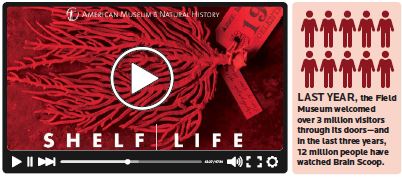
This article originally appeared in the September/October 2016 issue of Museum magazine.
How museums can use YouTube to engage visitors and extend their reach.
“YouTube is the new TV”—or so seemingly everyone tells me at VidCon, the annual conference for online video held in Anaheim, California, since 2010. But YouTube is more than TV. It’s one of the biggest social media platforms and the second-largest search engine, making it one of the top platforms on the Internet that people turn to for information, entertainment, and interaction.
It’s hard to argue with the numbers: a billion worldwide users have watched more than 70 million hours of video in the last year alone. The most popular channel—a video game-themed comedy show—has more than 46 million
subscribers. And YouTube is not just comedy and cat videos. More than 4.5 million people subscribe to the PBS partner channel Crash Course to watch educational videos. More than 3.9 million subscribe to get Smarter Every
Day with an aerospace engineer, and more than 3.5 million subscribe to the science channel Veritasium. That’s a lot of people voluntarily engaging in lifelong learning.
With so many people choosing to spend so much of their free time watching videos, should museums be excited or worried? The answer depends on what museums decide to do with it. Some have already embraced YouTube. The Field Museum in Chicago acquired the formerly independent science channel The Brain Scoop; the Natural History Museum of Los Angeles just launched The Curiosity Show, and New York’s American Museum of Natural History (AMNH), in addition to its other videos, launched a series called Shelf Life. And that’s just the science museums.
Think Outside the (TV) Box
There are many other museums that have YouTube channels. But there is a difference between a channel that hosts a bunch of videos—maybe recordings of guest speakers, virtual exhibit tours, and promotional videos for upcoming events—and a cohesive channel that functions more like an online television show. Anyone can do the former, and there’s nothing necessarily wrong with using YouTube as a video repository, but the potential of YouTube is much greater. TV-show-style channels not only offer consistent content that brings viewers back again and again, but offer museums the opportunity to build a large and engaged audience around their show’s online presence. Museums can interact with their viewers and present a more accessible, less intimidating face. It also offers the chance to grow a community and a passionate fan base. Videos can be more accessible to viewers, your online visitors, than any physical location. Plus, YouTube is popular with minorities and young adults (YouTube reaches more 18–34 year-olds than any US cable network)—audiences that some museums find difficult to reach.
So if a bigger audience and increased awareness are what museums stand to gain, what do they have to give? Even without the existing museum channels, there are many independent educational channels on YouTube, as well as those from PBS Digital Studios. A museum might not be able to compete with PBS for numbers of views—not to mention the channels of comedy and animal videos—but museums are storehouses of amazing things and knowledge. They’re stuffed to the rafters with incredible stories that matter so much to humans that we’ve
carefully boxed and labeled the associated objects for hundreds of years.
Museums are also highly trusted to deliver accurate information. YouTube is awash with independently created videos of highly variable quality. The ability to play an editorial and curatorial role on the Internet should not be underestimated. Sometimes you want to watch a funny video, and there are plenty of those. But when you want a high-quality mini-documentary that you can trust is accurate, where do you turn? The answer could be museums.
If you’re convinced it’s at least worth looking into (and I hope you are), here is a closer look at how the Field Museum and AMNH are using their YouTube channels.
DIY to Acquired: The Brain Scoop
You may have heard of the YouTube channel The Brain Scoop, hosted by Emily Graslie, chief curiosity correspondent at the Field Museum. The Brain Scoop features videos ranging from the dissection of a squirrel (Grossometer: Extreme) to explorations of the origin of mammalian movement. It has more than 340,000 subscribers. And, as Graslie points out, they’re highly engaged—at least enough to watch seven minutes of video about riffle beetles.
In the past three and a half years, people have viewed The Brain Scoop’s videos 12 million times, voluntarily educating themselves about the Field Museum’s research and collections. In addition, The Brain Scoop and Graslie are the epicenter of a lively online community of fans who seem to truly love the show and the museum. They care enough about The Brain Scoop to create fan art, send fan mail, and contribute money: in 2015, they collectively donated more than $155,000 to help build a new hyena diorama in the Field Museum’s Asian Hall of Mammals.
But The Brain Scoop didn’t start out at the Field Museum. It started at the Philip L. Wright Zoological Museum on the campus of the University of Montana. Graslie, then a volunteer passionate about sharing the collection, teamed up with producer Michael Aranda, supported by YouTuber and Montana resident Hank Green. They used a Panasonic video camera and a couple of borrowed microphones, “so the quality of the camera was pretty low,” recalls Graslie, adding, “It’s difficult to film in collections and exhibit spaces. Definitely get a tripod or monopod… [and] someone with good editing savvy.”
Graslie, Green, and Aranda produced videos in Montana for four months before the channel, with Graslie as host, were acquired by the Field Museum. Until the recent hire of a full-time video producer, The Brain Scoop team at the Field consisted of Graslie and one part-time producer who came to the museum once a month to shoot the videos. The goals of The Brain Scoop videos are, Graslie says, “to accurately depict the research that’s happening at the museum” without sensationalizing, as well as to show a diversity of scientists. “We want our viewership to walk away with a broader sense of what a scientist is or studies,” she says.
In House: Shelf Life at the AMNH
The American Museum of Natural History has had a YouTube channel since 2009, which hosts videos produced by in-house staff for promotion and education. After the museum received a large donated collection in 2014, Editorial Director Eugenia Levenson and Senior New Media Specialist Erin Chapman wanted to create a video series that would highlight some of the millions of objects in the museum’s care. They developed a pilot episode, and “everyone got excited about making a series,” says Chapman. The museum decided to make 12 videos, released once a month over the course of a year, highlighting objects and research from different departments. The series, called Shelf Life, is created and produced by Levenson, Chapman, and a freelance graphic designer. The videos are accompanied by a website that features articles, forming what the team refers to as an “ecosystem” of related content.
The goal, explains Chapman, “was to get people subscribing to our YouTube channel, and it did that once people knew there was something to follow.” The museum also received attention from journalists, who found story ideas within the videos, and scientists, who learned of objects in the museum’s collections that were of interest to their work.
Chapman and Levenson worked closely with museum scientists to find topics and stories to feature in their videos. Filming itself was “semi-scripted”—they had a clear idea of the story they wanted to tell but let the interviews with scientists organically guide the process. Once they had a sense of the video’s narrative, Chapman worked on storyboards, design, and animation in addition to shooting the actual footage. She and Levenson also took additional and photos that could be used on other platforms, such as Instagram, to draw viewers to the videos and articles.
The key, says Chapman, is identifying your institution’s strengths “and really capitalizing on that rather than trying to blanket the landscape with what you think is popular on YouTube.”
Getting Up and Running
Starting and maintaining a high-quality YouTube channel isn’t easy, but it doesn’t have to be insurmountably difficult or expensive. Survey what resources are available (including your museum’s own warehouse of incredible stories), and work with what you have.
Museums have several options when it comes to starting a channel: manage by committee, create an in-house team, or partner with an existing channel. I would not recommend creating and managing by committee. YouTube viewers prize authenticity and a personable voice, which is difficult to achieve when a committee is involved. In order to preserve spontaneity and liveliness, a small creative team (such as the host, writer, and producer) need to maintain creative control. “My videos don’t go through a review process, and I’ve been really adamant about that,” notes Graslie. The scientists screen the videos before they go live and “have liberty to say whether or not the information is correct, but they don’t get to dictate editorial changes. It creates a more authentic product in the end.”
Graslie’s autonomy at the Field Museum is key. Her role as an embedded journalist provides real benefits by separating the positions of storytelling, community building, and raising awareness from those that include marketing and revenue generation. When you have both on your plate, it’s really
hard to do either very well.
Better options may be to form an in-house team or acquire or partner with an existing channel. Either way will likely require senior staff to relinquish some control of the museum’s image, branding, and voice. That can be scary, but it’s also necessary. In addition to allowing an authentic personality to come through the videos, it allows the video team to maintain creative control.
It’s also important to figure out who will be in charge of the channel and how much money, time, and other resources will be allocated. Don’t be intimidated if your museum doesn’t have in-house production staff. It’s possible to assemble a team using any combination of staff and freelancers. If you can find someone passionate about telling stories who is interested in video as a medium, you’re halfway there—and that person can be an employee, a volunteer, or even a local YouTuber not yet affiliated with your museum. Take Michael Wilson, aka Coma Niddy, who started creating science-themed rap videos while working at the New York Hall of Science. When he moved to the Oregon Museum of Science and Industry, the museum gave him a platform and access to film his videos there. He also gets social media support and expert help from PBS Digital Studios—it’s a win-win-win. You don’t have to buy a bunch of expensive equipment, either. Recalling the early days of The Brain Scoop, Graslie advises that museums can get by with “a steady camera and good audio.”
Aim for less than 10 minutes per video. Shorter videos not only work better for online audiences but cost less money to produce. Time is money for video producers. There are countless bells and whistles that can be added or deleted from a project to affect the cost such as original music, graphics and animation, or stock footage.
It would take a book to cover everything you might need to know about creating a YouTube channel (and those exist, including YouTube’s own free playbook for nonprofits). At a very basic level, museums considering a YouTube channel should think about how it would fit with their mission, its goal, what content it would (and wouldn’t) include, who would manage it, and which internal and external stakeholders should be consulted or informed.
A plan of action will help maintain consistency of branding, video quality, style, and voice. All of these elements are key to letting viewers know what they can expect from your future videos—and keep them coming back!
Measuring Success: Is YouTube Worth It?
Like many museum endeavors, especially those with affective goals, the success of a museum’s YouTube channel must be measured against the institutional mission and the strategic goals of the channel. It might seem like tracking success online would be straightforward, but even video and web analytics should be taken with a grain of salt. Numbers of views and Facebook “likes” don’t necessarily indicate engagement or translate into visitors through the door. “Everyone wants to know, ‘How do we know if this thing is worth the investment?’” says Graslie. “I kind of come at it from a different perspective…This is communication, but it’s not looking to generate a ton of revenue for our institution. It’s outreach for our research scientists.”
Even when you have numbers, their meaning isn’t always clear. Last year, the Field Museum welcomed more than 3 million visitors through its doors—and in the last three years, 12 million people have watched Brain Scoop. “So if you’re talking about exposure and interaction,” says Graslie, “how do you bridge those numbers?”
What about the impact of online video on informal STEM education? The short answer is that there isn’t a solid body of research on this topic. We don’t even have definitive research on science and nature documentaries, which have been around for decades. What we do have is a strong intuition from many veterans of the field that this sort of communication works and is worth the effort. Reflecting on his decades-long career making award-winning documentaries, Chris Palmer, nature filmmaker and executive producer of the Oscar-nominated documentary Dolphins, says that “measuring ratings…of course is a ridiculous way to measure social impact of film. So there’s a whole other way to approach this, which is to just do the best you can…put them out there…and keep your fingers crossed.” It’s not an exact science or a sure bet.
Online video certainly isn’t a silver bullet, but it is one more tool in the toolbox of improving, promoting, and having fun with science education. “The goal,” says Smarter Every Day creator Destin Sandlin, “is just to enjoy learning.”
Where Do We Go From Here?
YouTube may be the new TV, but it’s also a whole new world and a huge free-choice platform. Many YouTubers are still trying to figure out how to make the most of it—even those who come from the old world of television. Online video offers museums new possibilities for reaching and engaging audiences if we’re willing to take a little risk. The good news is that we don’t have to do it alone. “We’re still kind of fragile online,” says Graslie of museums. “It’s so difficult to remain relevant and consistent in this sphere that we want to do whatever we can to support one another as [online content] creators.” A number of support systems already exist, including YouTube’s nonprofit community, which offers everything from troubleshooting help to video boot camps at YouTube’s studios (make sure to sign up as a nonprofi t when making your YouTube account). Hank Green, who helped launch The Brain Scoop and Crash Course, recently announced an Internet Creators Guild to support the community of online video creators. Several professional museum organizations hold workshops or have working groups focused on online content creation, including video. And museums shouldn’t be shy about seeking out helpful partnerships with established or emerging YouTube creators, freelance producers or film school students, enthusiastic staff and volunteers, and other museums. Every single museum probably doesn’t need its own YouTube show, but think what could come from a collaboration across museums.
“How do we use all of our powers to just make that community stronger?” Graslie asks. Her answer, in part, is for museums to support more curiosity correspondents like her. “There is no recipe. Give good storytellers the resources they need to make good content.”
Resources:
- YouTube basics for museums by Dixie Leigh
- Playbook for Nonprofits
Winifred Kehl is a bicoastal exhibit developer and science writer always looking for good ways to tell great stories about science, technology, engineering, and math. When she’s not making museum exhibits or nonfiction comics, she writes about ideas and issues in informal STEM education. You can find more about museums and science communicators using YouTube at winifredkehl.com.
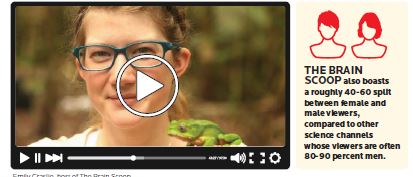
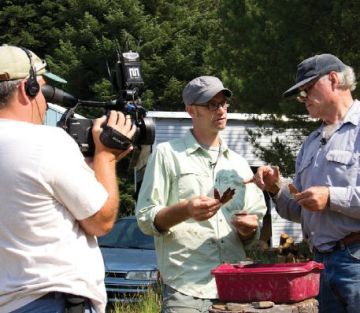
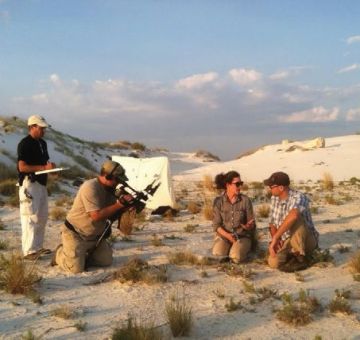




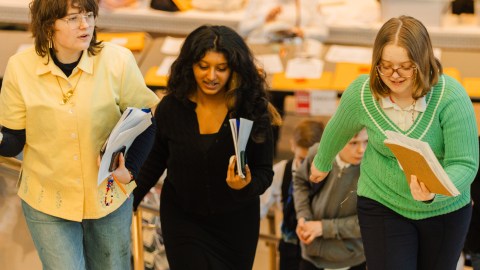
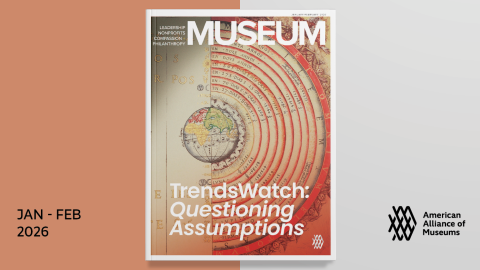
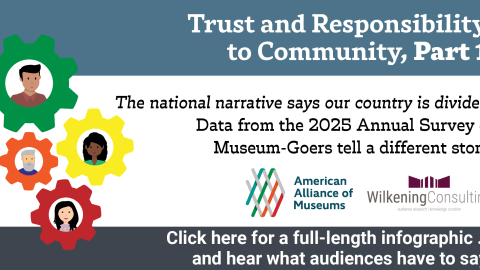

Everyone loves it when people get togethеr and share ideas.
Great website, continue the goοd work!